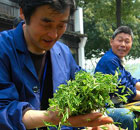Op-Ed Contributors
Dalai Lama group flounders in rebuffing Tibetan serfdom
By Zhang Yun (China Daily)
Updated: 2010-02-23 07:56
 |
Large Medium Small |
In order to glorify the old Tibet legal system, the article claims that the "legal system, and the rule-of-law (in old Tibet), became more advanced over the centuries," and that the essence of old Tibet's laws were that "the rulers should act as parents to their subjects," which was reflected in the "Thirteen Guidelines of Procedure and Punishment," and other codes of laws issued by rulers of old Tibet. "On the whole the system worked equally well for rich and poor (in old Tibet)," the article said.
However, these codes of laws, which were practiced in old Tibet for centuries, divided people into different social ranks. The value of the lives of higher ranked people, such as princes and living Buddhas, was equal to their body weight in gold.
For the lower ranked, such as women, butchers, hunters and craftsmen, the value of their lives was equal to a straw rope. Courts and prisons were set up by the local governments of old Tibet, as well as by large monasteries. Religious and secular landlords were entitled to set up their own private jails. Punishment was extremely savage and cruel. US scholar Tom Grunfeld once quoted a Briton who lived for two decades in old Tibet who said she had witnessed countless gougings of eyes and mutilations, while another in the late 1940s reported that "all over Tibet I have seen men who had been deprived of an arm or a leg for theft."
b. Describing the extremely backward and poverty-stricken feudal serfdom society as a "self-sufficient" one.
The Dalai Lama group claimed in the article that old Tibet was an "economically self-sufficient" society. "A very small percentage of the population - mostly in Central Tibet - were tenants. They held their lands on the estates of aristocrats and monasteries, and paid rent to estate-holders in kind or in physical labor," the article claimed, suggesting that those tenants were "relatively wealthy and were sometimes even in the position of loaning money or grain to the estate."
However, the fact was that all the arable land - pastures, forests, mountains, rivers and beaches - and most of the livestock in old Tibet were owned by government officials, aristocrats and high-ranking monks, as well as their representatives. These people made up only 5 percent of old Tibet's population. Meanwhile, tenants, who had no means of production and personal freedoms and survived by working on rented land, made up about 90 percent of the population. Another 5 percent of the population had been slaves for generations, and were regarded as "tools that speak."
According to statistics from the 17th century during the Qing Dynasty, Tibet had about 200,000 hectares of arable land. About 30.9 percent of the land was owned by the local feudal government, 29.6 percent by aristocrats, and 39.5 percent by monasteries and high-ranking monks. The dominance of the means of production by the three classes in old Tibet has not changed since that time.
In his book, Tibet Past and Present, Bell wrote that children were sometimes stolen from parents to become slaves in old Tibet. Parents who were too poor to support their children would also sell them in exchange for sho-ring, or "price of mother's milk" to other people, who would raise the children, keep them, or sell them again as slaves, he said. He also wrote in the book Portrait of a Dalai Lama: the Life and Times of the Great Thirteenth that the spread of diseases "caused the population, so sorely needed, to grow less and less. The huge number of monks, who are celibate, leads to the same result. Pneumonia, goiter, influenza and smallpox are also prevalent, the last being greatly dreaded. ... Children have to rough it in food and other ways, and many die young."









